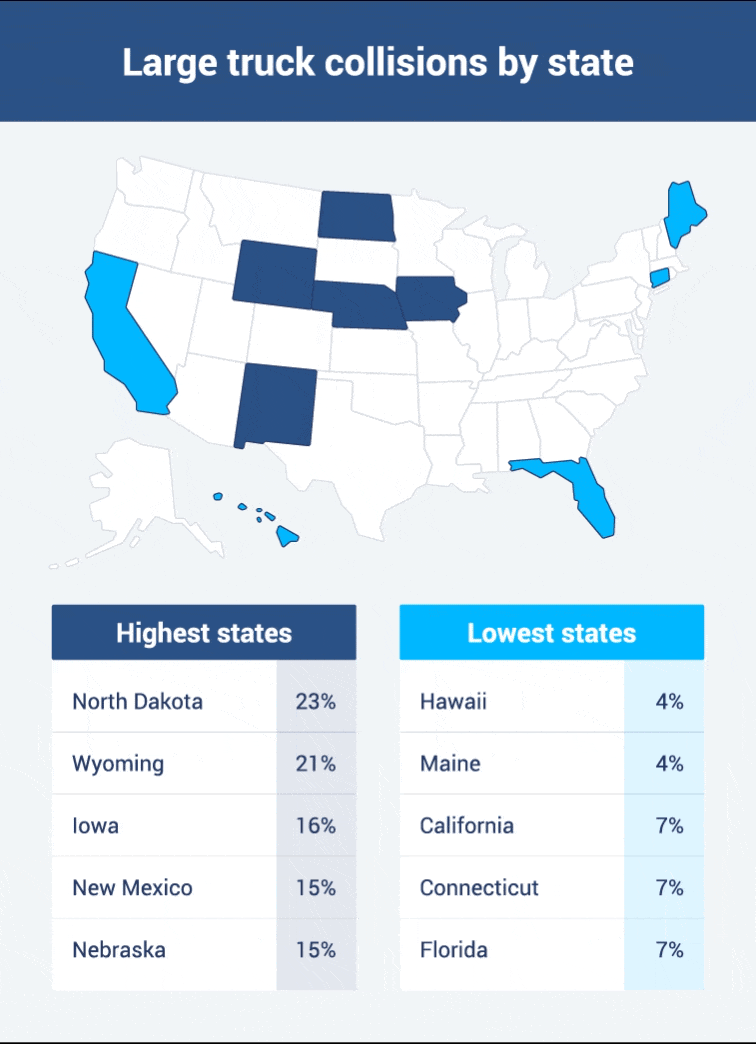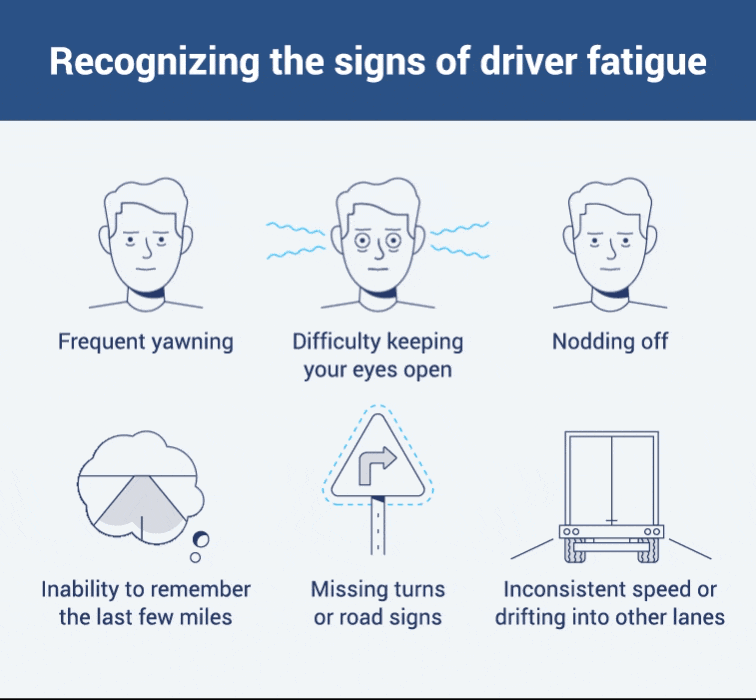35+ drowsy driving statistics and prevention facts for 2024
Do you know how many collisions are caused by drowsy driving each year? The answer is alarmingly high.
By Geotab Team
Nov 15, 2024

Key Insights
- Drowsy driving kills 693 people every year, and 6 in 10 adults admit to having driven drowsy. (NHTSA)
- Peak drowsy time for driving is between midnight and 6 a.m., as well as in the late afternoon. (NHTSA)
- North Dakota, Wyoming and Iowa have the highest percentage of large trucks involved in fatal collisions. (NSC)
- 35% of adults consistently sleep less than the recommended 7 hours per night, a major underlying factor in drowsy driving. (CDC)
- Only two states, New Jersey and Arkansas, have active drowsy driving legislation. (NSF)
Many companies rely on fleets to transport goods and reach remote job sites. However, the pressure to meet delivery deadlines can often lead to long hours and inconsistent driving schedules. And while we're regularly warned about the risks of drunk or distracted driving, there’s a new danger we need to wake up to: drowsy driving.
Driving while tired is a serious issue that can have devastating consequences. In fact, drowsy driving statistics show that 20 hours without sleep is the same as driving with a blood alcohol level of 0.08%, the U.S. legal limit.
Fleet managers must prioritize driver safety and combat risky driving habits like drowsy driving.
What is drowsy driving?
Drowsy driving is the act of operating a motor vehicle while being cognitively impaired due to a lack of sleep. Drivers often face long trips and inconsistent driving schedules, potentially leading to situations where they find themselves driving while tired and drowsy.
Technology can play a key role in reducing the number of fatigue-related collisions among fleet drivers. For example, vehicle features and ADAS solutions, including drowsiness and lane departure alerts, are prime examples of technology that can detect common drowsy driving habits and notify drivers to stay in their lane or take a rest.
Drowsy driving collision statistics
Despite its prevalence, many people underestimate the dangers of driving while fatigued. In fact, drowsy driving causes approximately 91,000 police-reported collisions and 50,000 injuries each year. However, implementing driver scorecards can help improve driver safety and manage high-risk behavior.
While drowsy driving is often compared to drunk driving, it's important to understand that the effects can be just as severe, if not more so. But just how many collisions in the U.S. involve a drowsy driver?
- There were 693 drowsy-driving-related deaths in 2022. (NHTSA)
- Driver sleepiness causes roughly 1 out of every 5 fatal car collisions. (NSF)
- For every 100 million miles traveled, there were 3.6% fewer deaths in car collisions in 2022 compared to 2021. (NHTSA)
- The estimated number of people injured on roadways decreased to 2.38 million, a 4.6% decrease from 2021. (NHTSA)
- Police-reported traffic collisions decreased by 2.8% from 6.10 million in 2021 to 5.93 million in 2022. (NHTSA)
- Traffic fatalities in collisions involving large trucks increased by about 2% from the previous year. (NHTSA)
- Fatigue-related collisions resulting in injury or death cost society $109 billion annually. (NHTSA)

Drowsy driving statistics by state
Drowsy driving is a silent killer on the road, contributing to an alarming number of fatalities each year. In fact, one person is killed every 12 minutes, and an estimated five people are injured every minute in traffic collisions.
The impact of this dangerous driving behavior varies significantly from state to state. Despite the widespread dangers of drowsy driving, there is a lack of proactive legislation in the trucking industry, highlighting the need for safety programs and telematics data.
- Only two states, New Jersey and Arkansas, have active drowsy driving legislation. (NSF)
- Hawaii, West Virginia and Alabama have the highest percentages of sleep-deprived adults. (CDC)
- Comparatively, Vermont, Minnesota and Colorado have the lowest percentages of sleep-deprived adults. (CDC)
- North Dakota, Wyoming and Iowa have the highest percentage of large trucks involved in fatal collisions. (NSC)
- The states with the fewest deaths from large truck collisions, like Rhode Island, Hawaii and Alaska, also have some of the lowest truck traffic. (NSC; Green Car Congress)

Driver fatigue statistics
Driver fatigue is a serious issue that affects people across all demographics, but certain groups are particularly vulnerable to its dangers. Those who work long or irregular hours, such as shift workers, truck drivers and medical professionals, are at increased risk.
Driver fatigue also poses an increasing threat to companies that rely on their drivers to be safe and alert. Unlike a breathalyzer, there are currently no tests that can prove impairment due to fatigue. Understanding top fleet safety insights, like who is most at risk, is crucial for preventing drowsy driving incidents.
- 60% of adults have driven drowsy. (NSF)
- Peak drowsy time for driving is between midnight and 6 a.m., as well as in the late afternoon. (NHTSA)
- Only about 30% of teens and adults believe that drowsy driving is extremely likely to lead to death or serious injury. (NSF)
- Middle-aged men (45-64) and Native Hawaiian or Pacific Islander adults are most likely to report insufficient sleep. (CDC)
- College graduates are more likely to admit to driving drowsy (74% vs. 55% for non-graduates), but nongraduates are more likely to do so at least once a year (29% vs. 20%). (NSF)
- At least 15% of all heavy truck collisions involve driver fatigue. (NSF)
- About 1 in 25 adult drivers (4%) report having fallen asleep while driving. (NCS)
- 65% of adults think drunk driving is extremely likely to lead to death or serious harm, while just 31% think the same for drowsy driving. (NSF)
- While 95% of Americans believe drowsy driving is risky, it’s estimated that over 37 million motorists drive drowsy. (NSF)
- 58% say work or school schedules prevented them from being alert while driving. (NSF)

Historical drowsy driving statistics
While drowsy driving remains a persistent problem, a look back reveals some interesting trends and shifts in the landscape of this dangerous behavior. Overall, traffic fatalities have slightly decreased in recent years, but the proportion of those deaths occurring outside the vehicle has risen considerably since 1996.
Knowing these historical drowsy driving facts can provide key insights into fleet safety trends and trucking statistics:
- The number of adults not getting enough sleep has remained consistent from 2013 to 2022. (CDC)
- The percentage of drivers admitting to falling asleep at the wheel has dramatically decreased from 37% in 2002 to just 4% in 2022. (AAA FTS; NCS)
- Younger drivers (16-24 years old) were almost twice as likely to be in a drowsy driving collisions compared to those aged 40-59 in 2010. (AAA FTS)
- Drivers accompanied by a passenger are nearly 50% less likely to be involved in a drowsy driving-related collision. This means solo truck drivers are more likely to feel sleepy while driving. (AAA FTS)
- Traffic deaths decreased by 1.7% in 2022, with 716 fewer people killed compared to 2021. (NHTSA)
- The proportion of people killed "inside the vehicle" has declined from 80% in 1996 to 64% in 2022, likely due to seatbelt safety, while the proportion of people killed "outside the vehicle" has increased from 20% in 1996 to 36% in 2022. (NHTSA)

Facts about driver fatigue symptoms
Fleet and business safety managers can increase safety by encouraging their drivers to spot key driver fatigue symptoms and stay off the roads when they feel tired or drowsy. Employing defensive driving techniques can also help improve alertness to avoid dozing off while driving.
Here are key driving fatigue symptoms and warning signs:
- Trouble focusing: This can manifest as blurry vision, difficulty keeping your eyes open, frequent blinking or feeling like your head is heavy. Frequent blinking and yawning are some of the most common drowsy driving signs.
- Mental fog: If you can't remember the last few miles driven, feel irritable or struggle to concentrate, you may be experiencing fatigue.
- Erratic driving: Watch out for drifting between lanes, tailgating or missing exits and signs. These are dangerous signs that fatigue is impacting your driving.

Drowsy driving prevention facts
The reality is that it’s the responsibility of both fleet organizations and their drivers to maintain the drivers’ safety and encourage best practices behind the wheel. With the help of technology such as dash cams, Geotab Drive and ELD, there is hope that many fatigue-related incidents can be avoided.
But what exactly does the data show about how to prevent drowsy driving?
- Despite the dangers, nearly 1 in 5 drivers believe they can safely drive even after getting 2 hours of sleep or less. (NSF)
- Of people who drive drowsy, 1 in 4 (25%) do so once per year or more. (NSF)
- 35% percent of US adults consistently sleep less than the recommended 7 hours per night, a major underlying factor in drowsy driving. (CDC)
- Drivers who get 7-9 hours of sleep are less likely to drive drowsy. (NSF)
- People who eat their meals at the same time every day have better sleep health than those with more inconsistent meal schedules. (NSF)
- Those who consistently get inadequate sleep are much more likely to drive drowsy at least once a year (30% vs. 18% for those who get enough sleep). (NSF)
- Stopping every 100 miles (or 2 hours) can help combat fatigue on longer trips. (NSF)
- Drowsiness alerts and lane departure warnings can help detect drowsy driving and warn drivers to stay focused. (NSC)

Enhance driver safety with the right telematics solution
Don't let drowsy driving statistics become your reality. Invest in a telematics solution that prioritizes driver safety and helps you prevent collisions before they happen.
For fleet managers, this starts with establishing clear policies and adopting technology that actively combats driver fatigue. But it’s also important to work with drivers to foster a culture that values alertness and responsiveness behind the wheel.
With the right fleet management software, you can significantly reduce fatigue-related incidents and ensure your drivers stay safe on the road.
Subscribe to get industry tips and insights
Frequently Asked Questions
Sixty percent of adults report having driven drowsy at some point in the past, and about 1 in 25 adult drivers report having fallen asleep while driving.
Driving can be tiring due to repetitive tasks, prolonged sitting, poor posture and dim lighting. If you're not well-rested, taking medications that cause drowsiness or have underlying health conditions, you're more likely to feel fatigued while driving. It's important to pull over and rest if you feel drowsy to avoid collisions.
Studies estimate that drowsy driving is a factor in 1.5 million U.S. car collisions annually, causing over 8,000 fatalities and 70,000 injuries. NSF estimates that 21% of fatal car collisions involve drowsy drivers.
Men aged 45-64 are most likely to report insufficient sleep, while young drivers, between the ages of 16-25 are more likely to engage in risky behaviors, including driving while drowsy.
The Geotab Team write about company news.
Table of Contents
Subscribe to get industry tips and insights
Related posts

9 strategies to increase fleet fuel efficiency and lower fuel costs
July 8, 2025
4 minute read

Creating a fleet safety culture that’s built to last: Lessons from Missouri DOT and NYC
July 7, 2025
8 minute read

Field service is losing money to bad data: Go beyond GPS with smarter telematics
June 27, 2025
3 minute read


Enhancing winter road maintenance with postseason materials usage analyses
June 20, 2025
6 minute read

The fleet safety incentive program checklist for driver engagement that lasts
June 19, 2025
2 minute read